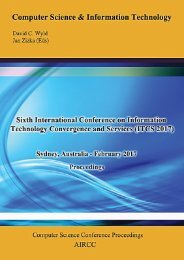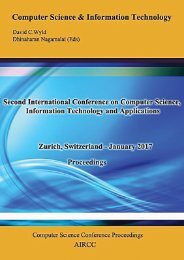CoSIT 2017
Fourth International Conference on Computer Science and Information Technology ( CoSIT 2017 ), Geneva, Switzerland - March 2017
Fourth International Conference on Computer Science and Information Technology ( CoSIT 2017 ), Geneva, Switzerland - March 2017
Create successful ePaper yourself
Turn your PDF publications into a flip-book with our unique Google optimized e-Paper software.
Computer Science & Information Technology (CS & IT) 83<br />
Where MAX is the maximum differentiation of the inputs (host file sample) compared with stego<br />
object in order to validate if the stego object holds secret data or not.<br />
The second metric used is Bit Error Rates (BER) which measures bit errors in a file, beside the<br />
summation number of bits required for the spread during a time period. The BER is the statistical<br />
measures in telecommunication transmission, the ratio result is percentage of a bit including<br />
errors comparing to entire bits. This measure is expressed as ten to a negative power. If the results<br />
is low data rate that means is very high in a transmission [15]. In addition, the BER is a measure<br />
of bit error probability. BER is considered more accurate while considering increased number of<br />
bit errors and long interval. BER is also used to measure the successful recovery of the hidden<br />
information. This will have its high effect in real communication channel where errors exists<br />
retrieving hidden information. BER is computed as described in the following equation:<br />
Where L is the length, H is host file and H' is stego object.<br />
Table 1 describes audio generators used during the experiment and explains specifications of each<br />
audio file including duration in minutes and size in Mbps. These audio clips were used in the<br />
evaluation study to measure the effectiveness of the proposed ALSB technique comparing to<br />
Standard LSB (SLSB) and XLSB techniques.<br />
Table 1. Audio file specifications<br />
Name of Audio<br />
generator<br />
Time<br />
(Minute)<br />
Pop 3:10 8.9<br />
Rock 3:40 9.9<br />
Blues 3:45 10.7<br />
Hip-hop 4:30 12.4<br />
Dance 5:30 14.2<br />
Metal 7:00 14.8<br />
Size under<br />
320kbps (MB)<br />
As shown in table 2, proposed ALSB achieved high PSNR values comparing to SLSB [17] and<br />
eXtended LSB (XLSB) methods [18] for all audio files. XLSB was presented and evaluated in<br />
[18]. While performing a T-Test between PSNR values of ALSB and SLSB the result in<br />
(p=0.00088), which indicates a significant difference between these PSNR values with an<br />
advantage to ALSB. Moreover, the BER result confirmed that the proposed ALSB over<br />
performed SLSB and XLSB. ALSB algorithm achieved the lowest BER values comparing to<br />
other algorithms. T-test between BER values of ALSB and SLSB results in (p = 0.0000735103),<br />
which ensures a significant difference between BER values with an advantage to ALSB.<br />
Accordingly, the proposed ALSB achieved high performance and outperformed SLSB<br />
algorithms.





